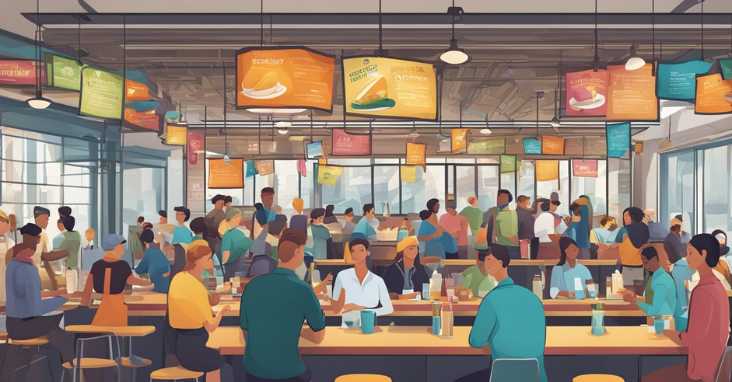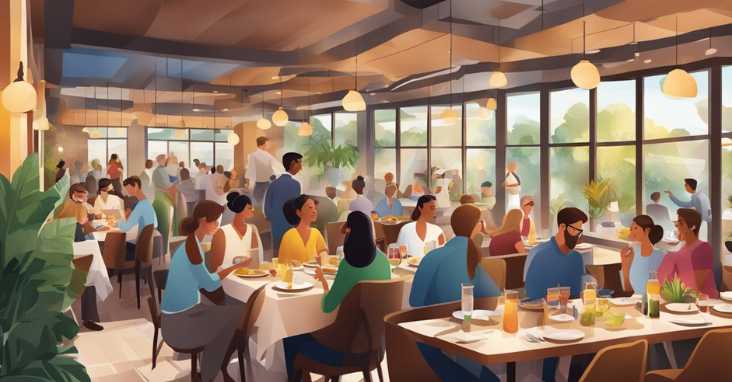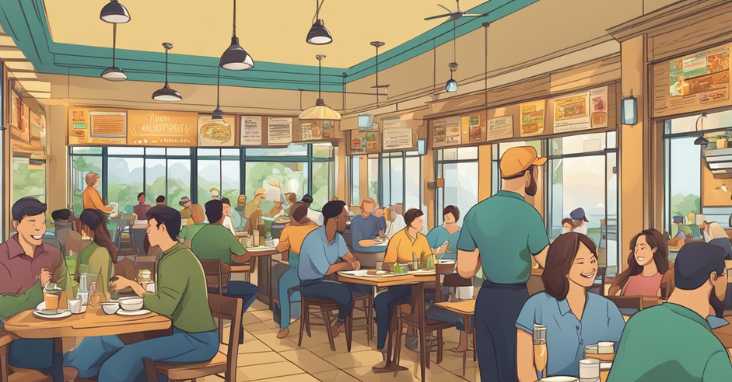What is restaurant marketing ? Restaurant marketing involves promoting eateries to attract customers using digital ads, social media, special events, and loyalty programs.
Restaurants face fierce competition in today’s market, and effective restaurant marketing is essential to attract new customers and retain existing ones. Restaurant marketing involves a range of strategies that aim to increase brand awareness, drive traffic to the restaurant, and ultimately increase revenue. From developing a restaurant marketing strategy to optimizing digital presence and engaging with customers through social media, successful restaurant marketing requires a multifaceted approach.

Developing a restaurant marketing strategy is the foundation of any successful restaurant marketing campaign. This involves identifying the target audience, setting marketing objectives, and determining the most effective marketing channels to reach them. Building a strong brand identity is also crucial to differentiate the restaurant from competitors and create a memorable experience for customers. This includes developing a unique brand voice, visual identity, and messaging that resonates with the target audience.
Key Takeaways
- Developing a strong restaurant marketing strategy is essential for success.
- Building a strong brand identity is crucial to differentiate from competitors.
- Optimizing digital presence and engaging with customers through social media are effective ways to increase brand awareness and drive traffic.
Source: National Restaurant Association
Developing a Restaurant Marketing Strategy
A well-crafted marketing strategy is essential for any restaurant to achieve its business goals. Developing a restaurant marketing strategy involves understanding the target audience, setting clear marketing goals, and allocating the restaurant marketing budget effectively.
Understanding Your Target Audience
To create a successful restaurant marketing strategy, it is crucial to understand the target audience. Demographics, customer data, and psychographics can help in identifying the target audience. Psychographics include customers’ interests, values, and lifestyle. By understanding the target audience, a restaurant can tailor its marketing efforts to connect with its customers better.
Setting Clear Marketing Goals
Setting clear marketing goals is essential for a restaurant marketing strategy. Goals should be specific, measurable, achievable, relevant, and time-bound. A restaurant marketing plan should have both short-term and long-term goals. Short-term goals can include increasing social media followers or email subscribers, while long-term goals can include increasing revenue or customer loyalty.
Allocating Your Marketing Budget
Allocating the marketing budget effectively is crucial for a cost-effective restaurant marketing strategy. A restaurant should allocate its marketing budget based on its marketing goals and the target audience. ROI (Return on Investment) should be considered when allocating the marketing budget. A restaurant should invest in marketing channels that provide the highest ROI.
One cost-effective restaurant marketing channel that a restaurant can use is email marketing. Email marketing can help a restaurant connect with its customers regularly and provide them with valuable information. According to a study by Campaign Monitor, email marketing has an average ROI of $42 for every $1 spent.
In conclusion, developing a restaurant marketing strategy involves understanding the target audience, setting clear marketing goals, and allocating the marketing budget effectively. By following these steps, a restaurant can create a cost-effective restaurant marketing plan that connects with its customers and achieves its business goals.
Here is a link to a guide on email marketing benchmarks by Campaign Monitor, a high-authority resource on email marketing.
Building a Strong Brand Identity
A strong brand identity is crucial for any restaurant looking to stand out in a crowded market. It helps to create brand awareness, foster brand loyalty, and differentiate the restaurant from its competitors. Building a strong brand identity involves several key elements that work together to create a cohesive and compelling brand image.
Creating a Compelling Brand Voice
One of the most important elements of a strong brand identity is a compelling brand voice. This refers to the tone, style, and personality of the brand’s communication. A strong brand voice helps to build an emotional connection with customers and can be a powerful tool for creating brand awareness and loyalty.
To create a compelling brand voice, restaurants should start by defining their unique brand personality. This can be done by considering the restaurant’s concept, target audience, and values. Once the brand personality is defined, it can be used to guide all communication, from social media posts to menu descriptions.
Designing an Instagrammable Dining Experience
In today’s social media-driven world, an Instagrammable dining experience is essential for building brand awareness. Restaurants should focus on creating visually appealing spaces that are both comfortable and photogenic. This can include everything from the decor to the plating of the food.
To design an Instagrammable dining experience, restaurants should consider the overall aesthetic of their brand and how it can be translated into the physical space. They should also think about how the space will be perceived by customers and how it can be used to create a memorable dining experience.
Leveraging Your Unique Restaurant Concept
Finally, a strong brand identity should leverage the unique concept of the restaurant. This can include everything from the menu to the decor to the overall atmosphere. By highlighting what makes the restaurant unique, it can create a strong brand identity that sets it apart from its competitors.
To leverage the unique restaurant concept, restaurants should focus on creating a cohesive brand image that is consistent across all communication channels. This can include everything from the logo to the menu design to the social media posts. By creating a strong brand identity, restaurants can build brand awareness, foster brand loyalty, and stand out in a crowded market.
For more information on building a strong brand identity for your restaurant, check out this article from QSR Magazine.
Optimizing Digital Presence
In today’s digital age, having a strong online presence is crucial for any restaurant looking to attract new customers and retain existing ones. Optimizing your digital presence can help improve your visibility in local searches and ultimately drive more traffic to your website and physical location.
Creating a User-Friendly Website
A user-friendly website is an essential component of any successful digital marketing strategy. Your website should be easy to navigate and provide visitors with all the information they need to make a decision about visiting your restaurant. This includes your menu, hours of operation, location, and contact information.
In addition, your website should be optimized for mobile devices to ensure that it is accessible to customers who are on-the-go. A responsive design that adapts to different screen sizes will help improve the user experience and keep visitors engaged.
Implementing Effective SEO Practices
Search engine optimization (SEO) is the process of optimizing your website to rank higher in search engine results pages (SERPs). By implementing effective SEO practices, you can improve your visibility in local searches and drive more traffic to your website.
Some effective SEO practices for restaurants include optimizing your website’s content with relevant keywords, creating high-quality backlinks from other reputable websites, and ensuring that your website is properly structured with meta tags and descriptions.
Managing Your Google Business Listing
Your Google Business listing is an important tool for improving your online presence and driving more traffic to your restaurant. By managing your listing, you can ensure that your business information is accurate and up-to-date, respond to customer reviews, and post updates about your restaurant.
To optimize your Google Business listing, make sure that your business information is complete and accurate, including your hours of operation, contact information, and menu. You can also add photos and videos to showcase your restaurant and its offerings.
By optimizing your digital presence, you can improve your visibility in local searches and attract more customers to your restaurant. For more information on optimizing your online presence, check out this guide to restaurant digital marketing.
Engaging with Customers through Social Media

Social media has become a crucial aspect of restaurant marketing, allowing businesses to engage with customers in a more personal way. Crafting a social media marketing plan is essential to ensure that your restaurant is effectively reaching its target audience.
Crafting a Social Media Marketing Plan
To create a successful social media campaign, it is important to first identify your target audience and the social media platforms they use most frequently. Instagram is a popular platform for restaurants, as it allows businesses to showcase their menu items and visually engage with customers.
Once you have identified your target audience and social media platforms, it is important to create a content calendar and plan out your posts in advance. This will ensure that your content is consistent and engaging. Utilizing a mix of promotional posts, user-generated content, and behind-the-scenes content can help keep your audience engaged.
Utilizing Influencer Marketing and User-Generated Content
Influencer marketing and user-generated content are effective ways to increase engagement on social media. Partnering with influencers who have a large following in your target audience can help increase brand awareness and drive traffic to your restaurant.
User-generated content, such as customer photos and reviews, can also help increase engagement and showcase your restaurant in a more authentic way. Encouraging customers to share their experiences on social media and featuring their content on your own page can help build a sense of community around your brand.
Monitoring Social Media Analytics
Monitoring social media analytics is crucial to understanding the effectiveness of your social media campaigns. Tracking metrics such as engagement, reach, and impressions can help identify what content is resonating with your audience and what can be improved.
Using analytics to make data-driven decisions can help optimize your social media strategy and ensure that your restaurant is effectively engaging with its target audience.
In conclusion, social media is a powerful tool for restaurant marketing. Crafting a social media marketing plan, utilizing influencer marketing and user-generated content, and monitoring social media analytics can help restaurants effectively engage with their customers and drive business. For more information on restaurant social media marketing, check out this helpful resource.
Maximizing Revenue Through Promotions and Campaigns

In the competitive world of restaurant marketing, promotions and campaigns play a crucial role in driving sales and maximizing revenue. By offering attractive special offers, organizing events and occasions, and leveraging email marketing campaigns, restaurants can increase their customer base and build brand loyalty.
Designing Attractive Special Offers
Special offers are a great way to attract new customers and keep existing ones coming back. Restaurants can design special offers that cater to different customer segments, such as students, families, or couples. For instance, a restaurant can offer a student discount during weekdays or a family meal deal during weekends.
To make the special offers more attractive, restaurants can use eye-catching graphics and copy that highlight the value proposition. For example, a restaurant can use bold and colorful graphics to promote a buy-one-get-one-free deal, or use persuasive copy to promote a limited-time offer.
Organizing Events and Occasions
Events and occasions are another effective way to drive sales and build brand loyalty. Restaurants can organize events such as live music performances, food festivals, or wine tastings to attract customers and create a memorable experience.
Restaurants can also leverage occasions such as Valentine’s Day, Mother’s Day, or Christmas to offer special menus or discounts. By creating a festive atmosphere and offering unique experiences, restaurants can differentiate themselves from their competitors and create a loyal customer base.
Driving Sales with Email Marketing Campaigns
Email marketing campaigns are a powerful tool for restaurants to drive sales and build customer loyalty. By sending newsletters and promotional emails to their subscribers, restaurants can keep their customers informed about new menu items, special offers, and upcoming events.
Restaurants can also use email marketing campaigns to segment their customer base and offer personalized promotions. For example, a restaurant can send a birthday discount to its customers or offer a loyalty reward to its frequent diners.
To make email marketing campaigns more effective, restaurants can use compelling subject lines, personalized messages, and clear calls-to-action. Additionally, restaurants can track the performance of their email campaigns and optimize them based on the results.
To learn more about maximizing revenue through promotions and campaigns, check out this resource.
Leveraging Customer Relationship Management

Customer Relationship Management (CRM) is a crucial aspect of restaurant marketing that can help businesses build and maintain strong relationships with their customers. By leveraging CRM, restaurants can develop loyalty programs, gather customer feedback through surveys, and enhance customer service, all of which can contribute to customer engagement and retention.
Developing Loyalty Programs
Loyalty programs are an effective way to encourage repeat visits and build a loyal customer base. By offering rewards and incentives to customers who frequent their restaurant, businesses can increase customer retention and drive revenue. According to a study by Harvard Business School, increasing customer retention rates by just 5% can lead to a 25-95% increase in profits.
Restaurants can develop various types of loyalty programs, such as point-based systems, tiered programs, or membership programs. These programs can be tailored to meet the needs of different customer segments and can be promoted through various channels, such as social media, email marketing, and in-store signage.
Gathering Customer Feedback through Surveys
Gathering customer feedback is essential for understanding their needs and preferences. By conducting surveys, restaurants can collect valuable insights that can be used to improve their menu, service, and overall customer experience. Surveys can be conducted through various channels, such as email, social media, or in-store tablets.
Restaurants can use online survey tools like SurveyMonkey or Google Forms to create and distribute surveys. They can also incentivize customers to complete surveys by offering discounts or free items.
Enhancing Customer Service
Providing excellent customer service is crucial for building and maintaining customer relationships. By ensuring that customers have a positive experience at their restaurant, businesses can increase customer satisfaction and loyalty.
Restaurants can enhance their customer service by training their staff to be friendly, attentive, and knowledgeable. They can also use technology like chatbots or mobile apps to provide quick and convenient customer support. Additionally, businesses can use customer service metrics like Net Promoter Score (NPS) to measure customer satisfaction and identify areas for improvement.
In conclusion, leveraging CRM can help restaurants build strong customer relationships and increase customer engagement and retention. By developing loyalty programs, gathering customer feedback through surveys, and enhancing customer service, businesses can create a positive customer experience and drive revenue. For more information on how to leverage CRM in restaurant marketing, check out this resource.
Analyzing and Improving Marketing Performance

Assessing Campaign Effectiveness
To determine the effectiveness of a marketing campaign, it is essential to analyze the data collected during the campaign. Analytics tools can be used to monitor metrics such as website traffic, social media engagement, and email open rates. By comparing these metrics to the campaign’s goals, marketers can assess whether the campaign was successful or not.
ROI (return on investment) is another crucial metric to consider when assessing campaign effectiveness. It measures the profits generated by the campaign compared to the cost of running it. By calculating ROI, marketers can determine whether the campaign was worth the investment or not.
Adjusting Tactics Based on Performance Data
Once a marketing campaign has been assessed, it is essential to adjust tactics based on the performance data. This could involve changing the target audience, adjusting the messaging, or modifying the timing of the campaign. By making these adjustments, marketers can optimize the campaign’s performance and increase its ROI.
Understanding and Increasing Customer Lifetime Value
Customer lifetime value is the total amount of money a customer is likely to spend on a business’s products or services over their lifetime. Understanding and increasing customer lifetime value is crucial for long-term profitability.
To increase customer lifetime value, marketers can focus on tactics such as improving customer service, offering loyalty programs, and providing personalized experiences. By increasing customer lifetime value, businesses can increase their profits and build long-term relationships with their customers.
It is important to note that analyzing and improving marketing performance is an ongoing process. By continuously monitoring and adjusting campaigns based on performance data, businesses can optimize their marketing efforts and maximize their profits.
For more information on analyzing and improving marketing performance, check out this resource.
Innovative Marketing Channels and Techniques

As the restaurant industry becomes more competitive, it is essential to utilize innovative marketing channels and techniques to attract new customers and retain existing ones. In this section, we will explore some of the most effective marketing channels and techniques that restaurants can use to stand out from the competition.
Exploring Wifi Marketing
One of the most effective ways to reach customers is through wifi marketing. By offering free wifi in your restaurant, you can collect valuable customer data and use it to create targeted marketing campaigns. This allows you to reach customers with personalized offers and promotions that are more likely to convert into sales.
To implement wifi marketing, restaurants can use a variety of tools and platforms such as Purple WiFi, Zenreach, or Aislelabs. These platforms offer features such as social login, data analytics, and email marketing integrations that can help restaurants optimize their marketing campaigns.
Utilizing Text Message Marketing
Another effective marketing channel that restaurants should consider is text message marketing. This allows restaurants to send targeted promotions and offers directly to customers’ phones, increasing the likelihood of conversion. Text message marketing is also a great way to promote events, new menu items, and special promotions.
Restaurants can use text message marketing platforms such as EZ Texting or Textedly to create and send targeted text messages to customers. These platforms offer features such as opt-in campaigns, automated messages, and message scheduling that can help restaurants streamline their marketing efforts.
Crafting Content Marketing for Foodies
Content marketing is an effective way to reach potential customers and build brand awareness. By creating valuable content such as blog posts, videos, and social media posts, restaurants can attract customers who are interested in their cuisine and brand.
Restaurants can create content that showcases their unique dishes, plating techniques, and craft beer selections to appeal to foodies and beer enthusiasts. They can also create content that educates customers about their ingredients, cooking techniques, and food sourcing practices to build trust and loyalty.
To create effective content marketing campaigns, restaurants can use tools such as Canva for graphic design, Hootsuite for social media management, and Google Analytics for data analysis.
In conclusion, restaurants that utilize innovative marketing channels and techniques such as wifi marketing, text message marketing, and content marketing can attract new customers and retain existing ones. By using these tools and platforms, restaurants can create targeted campaigns that resonate with their target audience and drive sales.
Local Marketing for Restaurants

Local marketing is an essential aspect of restaurant marketing. It helps restaurants to connect with their local community and increase their visibility among local customers. In this section, we will discuss some effective local marketing strategies that restaurants can use to attract more customers.
Building Relationships with Local Businesses
One of the most effective ways to market a restaurant locally is to build relationships with other local businesses. This can help restaurants to increase their visibility among local customers and attract more foot traffic to their location. Restaurants can partner with local businesses such as hotels, tourist attractions, and event venues to promote their services.
For example, a restaurant can offer a discount to customers who present a ticket stub from a local attraction. This can help to increase foot traffic to the restaurant and also promote the local attraction. Restaurants can also partner with local businesses to offer joint promotions and events.
Participating in Community Events
Participating in community events is another effective way to market a restaurant locally. Restaurants can participate in local festivals, fairs, and other community events to promote their services. This can help to increase their visibility among local customers and attract more foot traffic to their location.
Restaurants can also sponsor local events to increase their visibility and promote their services. For example, a restaurant can sponsor a local sports team or a charity event. This can help to increase the restaurant’s visibility among the local community and attract more customers.
Optimizing for Local SEO
Optimizing for local SEO is another effective way to market a restaurant locally. Restaurants can optimize their website for local searches by including location-based keywords in their content. This can help to increase their visibility among local customers who are searching for restaurants in their area.
Restaurants can also optimize their Google My Business listing to increase their visibility among local customers. This includes adding accurate information about their location, hours of operation, and menu items. Restaurants can also encourage customers to leave reviews on their Google My Business listing to increase their visibility and credibility.
In conclusion, local marketing is an essential aspect of restaurant marketing. By building relationships with local businesses, participating in community events, and optimizing for local SEO, restaurants can increase their visibility among local customers and attract more foot traffic to their location.
Here is an external resource with more information on local restaurant marketing.
Monitoring Industry Trends and Competitors

Keeping Up with Restaurant Industry Changes
In the fast-paced world of the restaurant industry, staying up-to-date with the latest trends and changes is crucial. By keeping an eye on emerging trends and shifts in consumer behavior, restaurant owners and marketers can adjust their strategies to stay ahead of the competition. This can involve conducting regular market research, attending industry conferences and events, and staying informed through industry publications and online resources.
One effective way to monitor restaurant industry changes is by following industry influencers and thought leaders on social media. By keeping tabs on their posts and insights, restaurant owners and marketers can gain valuable insights into emerging trends and best practices.
Analyzing Competitor Strategies
In addition to monitoring industry trends, it’s important to keep a close eye on competitor strategies. By analyzing the marketing tactics and offerings of competing restaurants, owners and marketers can gain a better understanding of what works and what doesn’t in their market.
This can involve conducting a thorough competitor analysis, which may include researching their menus, pricing strategies, social media presence, and customer reviews. By identifying areas where competitors are excelling, restaurant owners and marketers can adapt their own strategies to stay competitive.
Adapting to New Consumer Behaviors
As consumer behaviors and preferences continue to evolve, it’s important for restaurant owners and marketers to adapt their strategies accordingly. This can involve keeping tabs on demographic shifts, such as changes in age, income, and cultural diversity, as well as emerging trends in consumer behavior, such as a growing preference for healthy and sustainable food options.
By staying informed and adapting their strategies to meet these changing needs, restaurant owners and marketers can stay ahead of the curve and attract a loyal customer base.
To stay up-to-date with the latest industry trends and competitor strategies, restaurant owners and marketers can turn to resources such as the National Restaurant Association and Restaurant Business Online. These industry publications provide valuable insights and analysis on the latest developments in the restaurant industry, as well as tips and strategies for success.
Frequently Asked Questions

How can a restaurant improve its online presence to attract more customers?
Having a strong online presence is crucial for any restaurant looking to attract more customers. This can be achieved through various tactics such as creating a user-friendly website, optimizing the website for search engines, and maintaining active social media accounts. Additionally, listing the restaurant on popular online directories such as Yelp and Google My Business can help increase visibility and attract new customers. According to Hubspot, restaurants can also leverage email marketing to keep customers engaged and informed about special offers and events.
What are some effective strategies for engaging with customers on social media for restaurant promotion?
Social media is a powerful tool for promoting a restaurant and engaging with customers. Some effective strategies for engaging with customers on social media include posting high-quality photos of food and drinks, responding promptly to customer comments and messages, and running social media contests and giveaways. According to Sprout Social, restaurants can also leverage social media advertising to target specific audiences and promote special offers or events.
What innovative marketing tactics can help a restaurant stand out in a competitive market?
In a competitive market, it’s important for restaurants to differentiate themselves and stand out. Some innovative marketing tactics that can help achieve this include hosting unique events such as chef collaborations or themed dinners, partnering with local businesses to offer exclusive deals, and leveraging emerging technologies such as virtual reality or augmented reality. According to Toast, restaurants can also use personalized marketing tactics such as targeted email campaigns and loyalty programs to build strong relationships with customers.
How can local partnerships and community events be leveraged for restaurant marketing?
Partnering with local businesses and participating in community events can be a great way for restaurants to increase visibility and attract new customers. This can be achieved through sponsoring local events, collaborating with nearby businesses to offer joint promotions, or participating in food festivals and farmers markets. According to Restaurant Insider, participating in charity events can also help restaurants build a positive reputation in the community and attract socially conscious customers.
What role does customer feedback play in shaping restaurant marketing strategies?
Customer feedback is a valuable tool for shaping restaurant marketing strategies. By listening to customer feedback, restaurants can identify areas for improvement and adjust their marketing tactics accordingly. This can be achieved through soliciting feedback through online surveys or comment cards, monitoring online reviews and social media comments, and responding to customer complaints in a timely and professional manner. According to Upserve, incorporating customer feedback into restaurant marketing strategies can help build trust and loyalty with customers.
How important is it to align a restaurant marketing efforts with current food and dining trends?
Aligning a restaurant marketing efforts with current food and dining trends can be important for staying relevant and attracting new customers. This can be achieved through incorporating popular ingredients or cooking techniques into menu items, promoting seasonal or locally sourced ingredients, and offering unique dining experiences such as farm-to-table dinners or tasting menus. According to OpenTable, keeping up with food and dining trends can also help restaurants stay ahead of the competition and attract food enthusiasts and influencers.





